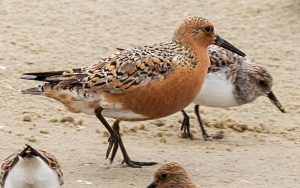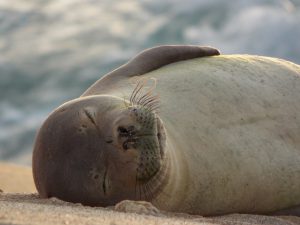BirdLife International is entering a second year of collaborating with LEX Reception to protect endangered shorebirds that migrate across the Americas. John Hannan explains more about how our partnership is supporting the nonprofit’s work.
“Birds hold a unique place in our lives, our national emblem, our sports teams, and so much of our literature and mythology feature birds. Meanwhile birds are probably the non-domestic animal we have the most connection to as they are found in every park, beach, and backyard across our country.
As I write this piece, the Cornell lab of Ornithology reports that approximately 24.3 million birds were in the sky last night, flying north on their spring migratory journey. But these large numbers hide a sad truth that, for many of our most beautiful bird species, their populations are in steep decline. For instance, the Red Knot, a long distance migrant has been in deep decline for the last twenty years. In 2021, only 7,000 were counted visiting Delaware Bay, a huge loss compared to the 82,000 seen in the early 1980s. And many of these birds were thin and unable to find sufficient food to survive the harsh trip further north. This is why LEX Reception and BirdLife have teamed up together to help preserve and protect this amazing species.

One of the reasons we picked the Red Knot is because it is a trans-hemispheric migrant. In the Western Hemisphere, this bird will fly from it nesting grounds in the mid to high-arctic down along the eastern Pacific and Atlantic coasts all the way down to the southernmost beaches of Chile and Argentina. This round-trip flight takes them more than 15,000 kilometers annually visiting almost every place LEX Reception services across the US and Canada.
If we were in a satellite soaring above the Americas we could track this amazing journey northward. I It started in late Jan- Feb. as the birds completed the first leg of their journey flying about 1,500km non-stop from southern Argentina and Chile to the Patagonia region. Right now, Red Knots are beginning to arrive in good numbers along the coast of Brazil. This is where they will refuel and double their normal body weight so they can fly 3,000 kilometers nonstop to the shores of Florida, Georgia, Delaware, and New Jersey, with numbers peaking in late May. The birds land exhausted, having used up almost every ounce of muscle and energy. Captured birds usually weigh about one third of their normal body weight. They flock to beaches where they can feast on horseshoe crab eggs, a food source that, for centuries, has provided them the high nutritional value to fly another 3,000 kilometers to the arctic, endure a potential snowy spring while producing and rearing young.
You can be part of the army of volunteers that are helping BirdLife and Lex Reception monitor and protect Red Knots. If you live along either the Gulf of Mexico, the Pacific or Atlantic coast you may encounter Red Knots. Become a citizen scientist, join ebird.org and put your observations into the world’s largest online conservation database.t It compiles simple birdwatching sightings and turns them into in-depth data that is guiding global species management, habitat protection, law, and policy decisions. You can look for Red Knots or any birds you like to watch, then you can enter your data from your phone, your tablet, or your computer. From there you can see how your data compares to others, find out what else is being seen in your neighborhood and continue to learn more and more about your community’s natural resources.

Another simple way for those on the coast to help Red Knots is to be on the lookout for Horseshoe Crabs. These amazing creatures have been on earth for centuries, pre-dating the dinosaurs. Unfortunately, they are not well adapted to some of the obstacle’s humans place on beaches and can get stuck or turned over. Horseshoe Crabs are not dangerous or aggressive so if you see one stranded on the beach, be a good friend of nature and turn it back over so it can continue to be a vital part of our ecosystem.
There are so many ways for you to become involved and engaged in protecting Red Knots and other endangered species. In the following months we will touch on some of the easiest, educational, and most fun ways to do it. Stay tuned and get out and enjoy nature!
Birdlife International

Birdlife is a global partnership of non-profit organizations devoted to protecting birds across the world. The BirdLife International Partnership is committed to reversing species decline. Their projects are always strategic, linking birds, habitats, nature, and people to create lasting change. Between on-the-ground actions, leading scientific research, and policy expertise, they have the tools to conserve migratory birds, like the Red Knot.
Everyone can support BirdLife’s plan to bring back the Red Knot – and many more of our threatened shorebirds.
As individuals, you can support our work with a tax deductible donation. If you also like to roll up your sleeves and volunteer, learn more by attending a lecture, or just find more online info on birds, click here to find your local Audubon chapter, or here for the American Bird Conservancy. Both these excellent nonprofits are BirdLife Partners in the USA. And for those who want to get out and enjoy the many Bird Festivals that occur across the country, celebrating birds and the beautiful landscapes they inhabit, click here for great ideas.
Without the help of LEX Reception clients and employees, we wouldn’t be able to support the conservation of species like the Red Knot. Thank you!”



